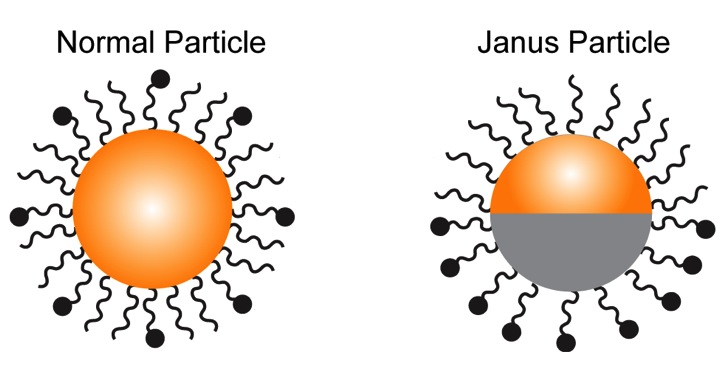How do you get foreign molecules in the body to fly under the radar of the immune system while at the same time engineer them to interact directly with immune system cells? When designing a drug, scientists walk a fine line between getting the body to notice a drug and not marking it as an invader. Researchers at Indiana University have developed particles that can do both.
A study from this year has shown that a Janus particle — a double-sided nanosphere named after the two-faced Roman God Janus — can split the two jobs between the two sides.
Janus particles are a few hundred times thinner than the thickness of your fingernail, so it’s not surprising that they are difficult to make. How do you preferentially coat only half of a uniform sphere? Imagine adding a dump truck of feathers to a bunch of bouncing soccer balls coated in molasses – the soccer balls would get completely coated with the feathers, the same way sticky particles floating in water get completely coated with a small molecule. If, however, you had a way to pack all of the soccer balls on the floor, so that the feathers couldn’t get to the bottom side, then you could coat half of each ball with the feathers leaving the other side still sticky.
The Yu Lab has perfected a technique that is much like selectively coating one half of a soccer ball (nanoparticle) with feathers (molecules). By using a method that packs nanoparticles close together on a surface, researchers can cover the top halves of the nanoparticles with many copies of a small molecule of their choice. After removing unattached molecules, the nanoparticles can then be released back into solution, and then a different molecule can be added to the nanoparticles bare side. Voila – Janus nanoparticles!
In the study, lead researcher Lucy Sanchez covered one side of the Janus particle with a molecule known to evade the immune system. When this evader molecule is attached to the particle surface it prevents the body from flagging it as garbage. The other side of the nanoparticle was covered with molecules that seek out a specific cell type, much like a metal detector finds metal, but ignores plastic, dirt, and concrete. In this particular case, the targeting molecules loaded on the nanoparticles could search for specialized cells called T-cells, which are important for fighting off infection.

The researchers showed that the Janus nanoparticles found their T-cell target 5 times more often that nanoparticles that were uniformly covered with both target and evader molecules, the latter nanoparticles serving as a control, or baseline for the experiment. The researchers hypothesized that because the evader molecule is thought to be bushy it might block the nearby targeting molecules on the control nanoparticles. This blocking effect doesn’t happen on the Janus particles, however, because the two molecules cover opposite sides of the particle.
But if the evader molecules were confined to only half of the nanoparticle, it would make sense that the body would tag and ‘eat’ those nanoparticles twice as many times as the control, since half of the particle is exposed. Surprisingly, the Janus nanoparticles were just as good in avoiding being eaten.
Researchers think the ability of Janus nanoparticles to evade the immune system police force has to do with how the body gets rid of them. Particle-eating cells interact with nanoparticles differently depending on what’s on the surface of the nanoparticle. When a molecule makes contact with a cell surface, the cell has a few choices. It can do nothing; it can engulf the particle; it can even spin the molecule or particle in circles at the cell surface! If the cell decides to engulf, it can do it in several ways. It seems that some processes of engulfment are more efficient than others, and each process is triggered by different kinds of molecules. Evader molecules present on the Janus nanoparticles give cells the cue to use a less efficient mechanism of “eating”, so when the cell attempts to devour the nanoparticle, it fails most of the time. It does not seem to matter if the nanoparticle is partially or fully covered with evader molecules – both examples result in less efficient engulfment by the cell. This happens even if the cells spin the nanoparticles to the side without evader molecules.
So it seems that insights from how the body interacts with Janus nanoparticles could give us the best of both worlds when designing drugs. One side of the nanoparticle causes a diversion to sneak under the immune systems radar, while the other side finds its target cell like a hound on the hunt. If therapy molecules can be designed to mimic the external surface of these Janus nanoparticles, we may see big advances in the efficiency and effectiveness of drug delivery in the future.
Edited by Fabio Mendes and Victoria Kohout

[…] lab has perfected a technique to pack these receptors very close together across a Janus particle’s surface, significantly […]